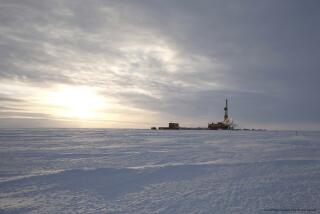40 Years After Statehood, Alaska Fights On
- Share via
ANCHORAGE, Alaska — The state of Alaska marks its birthday Sunday, 40 years since a remote, thinly populated territory overcame skepticism from the Lower 48 and became equal to every other state in the nation.
The statehood struggle may now be the stuff of history books, but some of the same conflicts with the federal government that drove that quest remain.
Becoming a state took some time and many trips to Washington. But in the end, statehood supporters made their case, and on Jan. 3, 1959, Alaska’s became the 49th star on Old Glory.
For the 215,000 people who lived in Alaska at the time, statehood meant freedom from the indignity of not being able to vote in presidential elections, from being forced to pass through U.S. Customs upon arrival in the Lower 48, from having governmental decisions made thousands of miles away in Washington.
“It all comes back to resources,” said Sen. Ted Stevens (R-Alaska). “And it’s going to remain a problem for a long time.”
Stevens, now 75, was part of the 1950s statehood struggle as a young Interior Department lawyer in charge of the agency’s relations with Congress. Once the Eisenhower administration lined up behind statehood, he became the middleman for determined Alaskans making the two-day flight to Washington.
Former Gov. Walter J. Hickel, then a go-getting Anchorage developer, says he made at least a dozen trips East to lobby. It didn’t take long to figure out whom he had to convince.
“It was really the senior members of the Senate that gave us what we needed,” recalled Hickel, now 79. “You had to get the seniority to win.”
Alaska won in Congress by a comfortable margin in 1958 and thought it was getting out from under the federal thumb when it came to its resources. To Alaskans, that meant land--the right to hunt and fish on it, to mine it and drill it, and to preserve it in its natural state.
The amount of land in Alaska is not the problem. How it’s used is. The new state government was granted about 28% of the land--an area larger than California. The federal government, however, kept 64% of Alaska, just as it controls large sections of many Western states. The rest is private or tribally owned.
The statehood deal called for much of the federal land to be opened to resource development, with the state getting 90% of the revenue generated. But over the years, as environmental protection became a greater value to Americans, more and more of the federal land has been closed off to development.
Billions of gallons of oil could lie under the Arctic National Wildlife Refuge, but the area is off-limits to drilling. Logging has been cut back sharply in the Tongass National Forest in recent years, and many gold miners seethe about rules that make it hard to even cross federal land to reach their claims.
More wilderness and parkland has cheered Alaska’s growing legion of conservationists.
“We have to realize that 60% of Alaska belongs to all of the people in the United States, including us, and we don’t have jurisdiction over these lands,” said Claus Naske, a statehood expert at the University of Alaska.
But that view isn’t held by the state government, which in 1993 filed a $29-billion lawsuit against the federal government for lost revenue and other damages.
“We have a few battles, and we’ll win them,” said Hickel, who filed the lawsuit. “But we have to fight them.”
The federal government has also riled many Alaskans with its threat to take over most of the state’s fisheries.
Interior Secretary Bruce Babbitt has insisted that the state match federal law by giving those who fish and hunt for subsistence first shot. Alaska legislators have refused to change the state law, which gives everyone equal access, and have sued the federal government over the issue.
Also as it did in 1959, the state is struggling with how to pay its bills. Alaska still remains heavily dependent on natural resources. Back then salmon was king; now it’s oil.
“In many ways we’re still a colonial economy,” Naske said. “Most of what we produce goes to the contiguous states and elsewhere for processing.”
But for those who were there for the front end of statehood, the vision they held in January 1959 lives on.
“I’m not disillusioned at all,” Hickel said. “I say it’s going to be great. We just have to make it work.”
More to Read
Sign up for Essential California
The most important California stories and recommendations in your inbox every morning.
You may occasionally receive promotional content from the Los Angeles Times.












